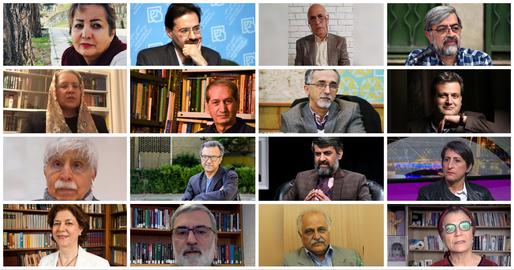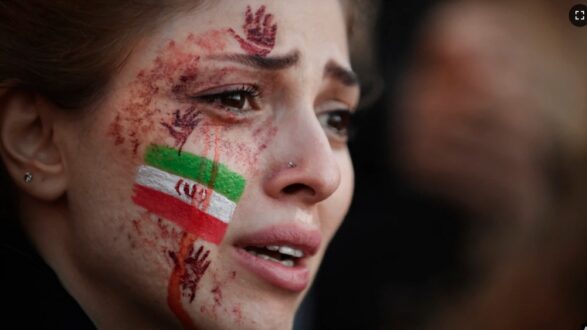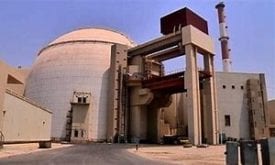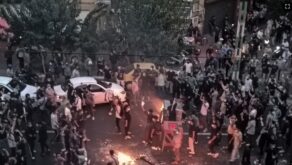Iranwire – For the first time, more than 40 political, social and human rights activists inside and outside Iran, some from inside the Islamic Republic’s prisons, joined a two-day virtual seminar to try to answer the question: How to save Iran?

Twenty-three participants live in Iran, and eight of them are in prison. Those living in Iran delivered their speeches beforehand in written or video formats.
The first day of the virtual seminar was held on April 21 with an audience of at least 16,000. The following is a summary of the discussions on the second day of the event.
***
While every aspect of the lives of Iranians is engulfed in a crisis, from the economy to human rights, especially the rights of women and religious minorities, many analysts believe that the only way to save Iran is to continue protests until the downfall of the Islamic Republic.
The authorities, however, have used every means at their disposal to suppress any kind of dissent, including brutal violence. Security forces have killed hundreds of protesters, unlawfully detained thousands and executed at least four demonstrators.
“Every Day we Witness Women who Boldly Hold their Heads High”
The first panel of the second day of the seminar, titled “Let us hold hands in kindness”, was moderated by journalist and religious scholar Mohammad Javad Akbarin. The speakers included university professor and women’s rights activist Nayereh Tohidi, journalist and political activist Alireza Rajaei, political activist Ali Keshtgar, lawyer and religious scholar Sedigheh Vasmaghi and photojournalist and civil rights activist Alieh Motallebzadeh.
According to Vasmaghi, the protest movement has “reached a decisive and fateful moment that makes it incumbent on every patriot to focus on it and find solutions.”
“The most important need of our movement today is to form a far-reaching front and a coalition of groups inside and outside the country to call for change,” she said. “This far-reaching front must be able to function as the brain of the movement, guide it, make plans and be trusted by the people so that the movement can advance.”
Motallebzadeh, who was summoned by the authorities after her recent release from prison, said that “Iranian women continue their fight against the Islamic Republic.” “Every day we witness women who boldly hold their heads high and fight the government face-to-face by violating the forced hijab law.”
“Throughout the years, the Islamic Republic has done everything in its power to put restrictions on women but it has boomeranged on them. Women have become stronger every day, to such an extent that today their insistence on the right to choose their outfits has become a symbol of the fight for freedom. And, as a result of the violent response by the government, this fight has turned into a political fight against the regime.”
“Despite the violent suppression by the government, we have witnessed rounds and rounds of demonstrations by the people, including the ‘Woman, Life, Freedom’ protests, during which, in the past year, people tenaciously fought in the streets and the world heard their cries of hatred and repugnance.”
Freedom, Justice, Democracy
The second panel, titled “Cultural Developments to Save Iran,” was moderated by journalist and nationalist-religious activist Taghi Rahmani. The speakers included Islamic theologian and university professor Mohsen Kadivar, philosophy professor Ehsan Shariati, political activist Ghorban Behzadian-Nejad, university professor Abdollah Nasseri, political scientist and academician Hatam Ghaderi and political activist Mehdi Nasiri.
Shariati said that the future Iran must be built on freedom, justice and democracy, building on the lessons learnt from the failure of previous movements and revolutions, from the Constitutional Revolution of 1905 to the 1979 Islamic Revolution and the events that followed.
Kadivar approved the slogans and demands of the 1979 revolution, but he listed mistakes made by the revolutionaries of those years so that the new revolutionaries avoid repeating them. Unlike many of those who played a role in the 1979 revolution, Kadivar claimed that establishing an “Islamic government” was indeed a goal of the revolutionaries in that year, a claim that has been repeatedly denied by the left-leaning groups that were active in the 1979 revolution.
The islamic Republic: A “Decrepit Body”
The last panel, titled “Blocs and Charters: A Way Towards the Future,” was moderated by journalist and political activist Reza Alijani. Speakers in this panel included publisher, journalist and political activist Alireza Beheshti Shirazi, political activist Maryam Setvat, women’s rights activist and writer Mansoureh Shojaee, political activist Hossein Rafiei, political activist Abdollah Momeni and university professor Mehdi Noorbakhsh.
Shojaee emphasized that the “Woman, Life, Freedom” movement will be a source of inspiration for analysts, historians and artists across the world for years to come because of the way it was conducted, the demands that it made and its adherence to the principle of non-violence.
According to her, the protest movement followed a path toward creativity and change, not toward destructiveness. She cited the charters that people themselves wrote as an example of these “creativities.”
Momeni described the Islamic Republic as a “decrepit government.” “The current Iranian government is like a decrepit body whose various organs no longer follow its brain. Even if the brain decides to slightly distance itself from corruption and authoritarianism, other organs of this body would refuse to follow such an order,” he said.
“Finding a way to save Iran is more than a political program; it’s the natural reaction of the people to prevent the annihilation of their own present and their children’s future.”
 Shabtabnews In this dark night, I have lost my way – Arise from a corner, oh you the star of guidance.
Shabtabnews In this dark night, I have lost my way – Arise from a corner, oh you the star of guidance.



